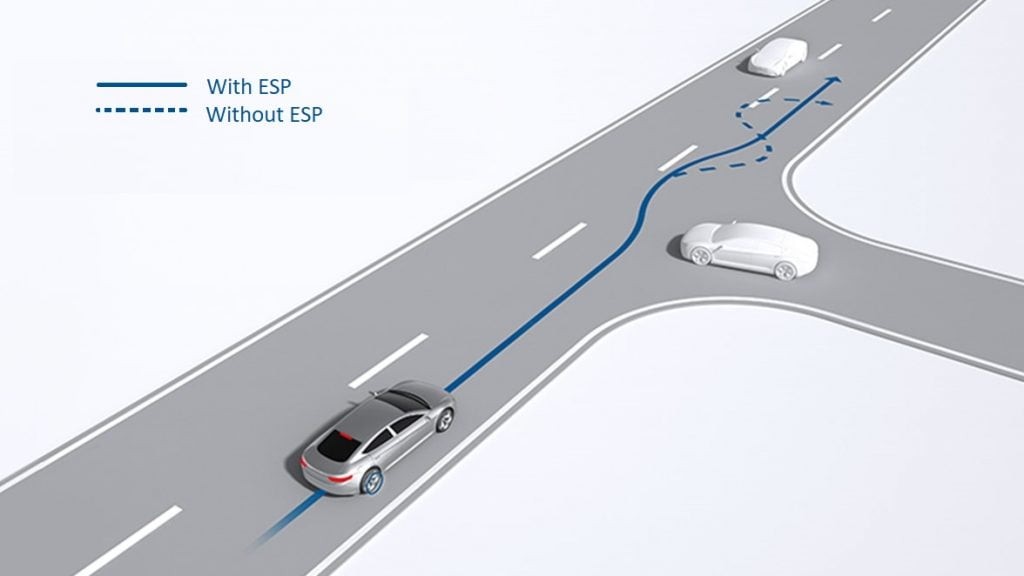Electronic Stability Program (ESP), sometimes also referred to as Electronic Stability Control (ESC), is a crucial safety feature in modern vehicles. It’s so vital that studies have demonstrated its effectiveness in significantly reducing accident rates. For instance, research in the UK indicates that ESP can decrease the likelihood of fatal accidents by as much as 25%. Similarly, Swedish studies suggest a reduction of up to 32% in fatal accidents during adverse weather conditions for cars equipped with this system.
To truly appreciate the significance of ESP, one needs to experience driving a vehicle both with and without it, especially when pushing beyond grip limits in a controlled environment like a test track. The difference in vehicle control and stability becomes strikingly apparent.
It’s worth noting that while ESP is now a standard feature in most new cars, this wasn’t always the case. The European Union mandated ESP installation for all mainstream vehicles only from 2014 onwards. Certain low-volume sports cars, such as the Ariel Atom and Caterham 7, are still exempt from this requirement, highlighting the performance-focused nature where driver skill is often prioritized over electronic intervention.
Understanding How ESP Works
ESP functions as an integrated system, working in conjunction with other vital safety technologies like the Anti-lock Braking System (ABS) and Traction Control System (TCS). ABS is designed to prevent wheel lock-up during hard braking, maintaining steering control. TCS, on the other hand, prevents wheel spin during acceleration, ensuring optimal traction. In simpler terms, ABS stops wheels from locking while braking, and TCS prevents them from spinning while accelerating.
ESP’s operation is deeply intertwined with both ABS and TCS. It leverages these systems to detect and respond to discrepancies between the driver’s intended steering input and the vehicle’s actual direction of travel.
The core function of the Electronic Stability Program is to continuously monitor the steering wheel angle relative to the vehicle’s intended path. It achieves this by measuring individual wheel speeds, yaw rate (the car’s rotation around its vertical axis), and steering angle approximately 25 times every second. By doing so, ESP is designed to compensate for driver errors that could lead to a loss of control, particularly in lateral dynamics (sideways movement). While ABS and TCS manage longitudinal dynamics (forward and backward movement), ESP focuses on keeping the car stable during turns and maneuvers.
If the vehicle begins to lose lateral traction, causing either the front or rear wheels to slide sideways (resulting in a skid), ESP intervenes to mitigate the skid. It does this by reducing engine power when necessary and selectively applying brakes to individual wheels. This precise braking action helps to steer the car back in line with the driver’s intended steering direction.
In an understeer situation, where the front wheels lose grip and the car doesn’t turn as much as intended, ESP applies the brake to the inside rear wheel. This action helps to rotate the car more effectively into the turn. Conversely, in an oversteer situation, where the rear wheels lose grip and the rear of the car swings out, ESP applies the brake to the outside front wheel. This creates a pivot point that helps bring the rear of the car back under control.
 Bosch ESP diagram
Bosch ESP diagram
Alt text: Diagram illustrating the components and functionality of a Bosch Electronic Stability Program (ESP) system in a vehicle, highlighting sensors, control unit, and interaction with ABS and TCS for enhanced car safety.
Original image source – Bosch
Depending on the vehicle manufacturer and model, the ESP system can encompass a range of supplementary functions that further enhance safety and control. These may include Electronic Brakeforce Distribution (EBD), which optimizes braking force between front and rear wheels, brake disc wiping to keep brake discs dry in wet conditions, brake pre-fill to prepare brakes for quicker response, and Emergency Brake Assist (EBA) to maximize braking force during panic stops. Interestingly, many tire pressure monitoring systems (TPMS) also utilize the ESP software to gather readings, simplifying the system and avoiding the need for complex valve assemblies within each wheel.
Key Driving Consideration
It’s essential to remember that even with advanced active safety systems like ESP, every vehicle is still governed by the laws of physics. ESP can only respond to steering input; therefore, it becomes less effective if the driver fails to steer in the desired direction. Driver awareness and proper steering technique remain paramount for safe driving, even in ESP-equipped vehicles.
Understanding the ESP Warning Light
When your car is running, the ESP warning light on the dashboard may illuminate in two distinct ways, each indicating a different situation:
- Steady Illumination
- Flashing
Steady ESP Warning Light
A consistently lit ESP/ESC warning light, typically represented by a symbol of a car with skid marks behind it, indicates that the system is currently inactive. This could be because it has been manually switched off by the driver or a passenger (if the vehicle has a manual override switch), or it might signal a system malfunction. Often, a steady light can be triggered by a temporary fault, such as a sensor overheating. In such cases, allowing the system to cool down and then ‘rebooting’ it by turning off the ignition, waiting briefly, and restarting the engine can sometimes resolve the issue.
It’s also important to be aware that some vehicles may automatically partially or completely disable ESP when specific driving modes are engaged. For example, “Race” mode in an Alfa Romeo Giulia Quadrifoglio might completely disengage ESC, while “Track” mode in Aston Martin and certain sporty Jaguar models may reduce the sensitivity of DSC (Dynamic Stability Control), allowing for more dynamic driving before the system intervenes. Familiarizing yourself with your car’s specific behavior in different driving modes and situations is crucial for safe and confident driving.
By default, ESP is designed to be always ‘on’ and ready to assist every time the engine is started. This ensures that the system is active from the beginning of each journey, preventing accidental driving without ESP engaged.
If the ESP warning light remains illuminated even after attempting a reboot and allowing sufficient cool-down time (around 30 minutes or more), it indicates a persistent issue that requires professional attention. A visit to a qualified dealer or a specialist mechanic is necessary to diagnose and repair the problem.
Flashing ESP Warning Light
A momentarily flashing ESP light while driving indicates that the Traction Control System is actively intervening. When the vehicle detects wheel slippage, ESP engages to help regain the intended driving path, and the light flashes briefly to signal this intervention. This flashing light can be interpreted as a prompt to drive more cautiously and pay closer attention to road conditions and grip levels. ESP is more likely to activate in challenging driving conditions such as mud, ice, or snow, highlighting its role in maintaining control in slippery environments.
Conclusion: The Indispensable Role of ESP
The Electronic Stability Program is an incredibly valuable safety technology that significantly reduces the risk of accidents caused by uncontrolled skidding. If you are interested in experiencing firsthand how your car behaves with and without ESP assistance in a safe and controlled environment, consider participating in a dynamic driving course. Courses like Dynamic Driving or Total Control courses offer excellent opportunities to understand and test these systems and enhance your driving skills in challenging situations. Understanding “What Is Electronic Stability Program In Cars” and its function is a key step towards safer driving in modern vehicles.
